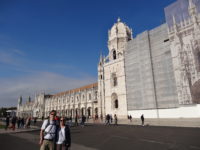 After a long day of touring yesterday, we slept in a little, finally getting launched around 9:30, and grabbing breakfast at a nearby cafe. Mer promised a much easier day today, and we started easily enough with grabbing a trolley heading west out of town. The trolley was ten minutes late, which meant it was very crowded, even at 10:00, with most of the passengers being tourists and heading where we were – St. Jerome’s Monastery in the nearby suburb of Belem.
After a long day of touring yesterday, we slept in a little, finally getting launched around 9:30, and grabbing breakfast at a nearby cafe. Mer promised a much easier day today, and we started easily enough with grabbing a trolley heading west out of town. The trolley was ten minutes late, which meant it was very crowded, even at 10:00, with most of the passengers being tourists and heading where we were – St. Jerome’s Monastery in the nearby suburb of Belem.
St. Jerome’s Monastery was built around 1500 by King Manuel, and it is about three hundred yards long, with a large church on one side and the monastic halls stretching along from the church. You can tour the church for free, which meant it was fairly crowded. The church and halls are distinctive – the arches holding up the roof and the columns are shaped in the forms of ropes, and there are sea motifs all over. The church is large and airy feeling, especially for 1500. I liked the church well enough, but the cloister was lovely.
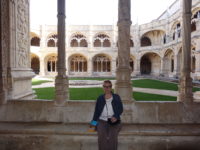 The cloister, probably based on the ten-euro entry fee, was far less crowded and much larger than the church, with a two-level portico built around a square. The entry fee also granted us access to the choir loft of the church, which offered better (and quieter) views of the church itself. Back out on the portico, we ran into some kind of play going on for a school group, with a devil (with horns), an angel, and several monks. We walked past the angel, who was sitting on a stepladder, and he smiled and nodded, since angels are friendly. These are the wacky, fun moments of travel.
The cloister, probably based on the ten-euro entry fee, was far less crowded and much larger than the church, with a two-level portico built around a square. The entry fee also granted us access to the choir loft of the church, which offered better (and quieter) views of the church itself. Back out on the portico, we ran into some kind of play going on for a school group, with a devil (with horns), an angel, and several monks. We walked past the angel, who was sitting on a stepladder, and he smiled and nodded, since angels are friendly. These are the wacky, fun moments of travel.
After the monastery, we crossed through a park and under a busy road to the enormous Monument to the Discoveries, a huge concrete block carved roughly in the shape of a ship with great men (and one woman – a queen) carved upwards to the prow of the boat. It was originally built in 1940 for a World’s Fair, but the gypsum model was torn down and a replica was rebuilt in the 1960s. It is a lovely place to sit, with the 25th of April Bridge behind it (looking back toward town) or looking down river toward the Atlantic. You can pay a few euros to climb to the the 170-foot tall structure, which Dubbs and Mer did, while I stayed below soaking up the sun and people-watching. Mer said there was also an exhibit in the monument called “Red Atlantic” about the slave trade and the native peoples who were exploited during the age of exploration and colonization.
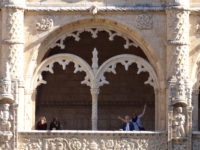 We had lunch in an Italian restaurant that looked out at the monument and river, along with the bridge and the statue of Christ. We decided for the more efficient way back into town, and so we skipped the trolley and took the real train back home, where we rested in the apartment for about half an hour, until 3:15.
We had lunch in an Italian restaurant that looked out at the monument and river, along with the bridge and the statue of Christ. We decided for the more efficient way back into town, and so we skipped the trolley and took the real train back home, where we rested in the apartment for about half an hour, until 3:15.
Mer decided to continue to take it easy on us by having us tour by trolley. We rode the #28 trolley around for most if the evening, which is a trolley that meanders through Lisbon, going through many of the tourist-friendly areas (and a few less-touristed areas too). Our first stop was at the end of the #28 line, at a large cemetery. Mer and I like to go to cemeteries – they are interesting and usually in pretty places. This cemetery got off to a good start, with a group of four or five cats hanging out near the gates. The attendant at the the cemetery church would not let us in the church for some reason (maybe it was too close to closing time in thirty minutes), but we got to wander the impressive rows of mausoleums of some of Lisbon’s wealthy families. The monuments were tightly packed together, and for the most part were fancy and well kept. Several had glass in the front doors, so you could see the coffins and the photos or flowers placed by the family. On the way out, we saw a momma kitty and her three kittens, so that made us smile.
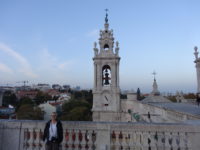 We took #28 down to Estrela Basilica, a large church that allowed you to climb up to the roof (for a small fee). The views of the surrounding area were fine, and if you dared, you could go into the dome of the church and look down to the church floor. Meredith and Dubbs dared, while I got very interested in the outside of the dome. The inside of the church was clear of statues and columns, but the ceilings were painted in geometric patterns. They had chants playing on the speaker system, which was wonderfully atmospheric. We sat and contemplated or prayed, and then crossed the street to another fine Lisbon park, to use the restroom.
We took #28 down to Estrela Basilica, a large church that allowed you to climb up to the roof (for a small fee). The views of the surrounding area were fine, and if you dared, you could go into the dome of the church and look down to the church floor. Meredith and Dubbs dared, while I got very interested in the outside of the dome. The inside of the church was clear of statues and columns, but the ceilings were painted in geometric patterns. They had chants playing on the speaker system, which was wonderfully atmospheric. We sat and contemplated or prayed, and then crossed the street to another fine Lisbon park, to use the restroom.
We rode #28 to the other terminus, which was in a fairly tourist-free area, so after a few minutes of searching for a restaurant, we gave up and got back on the #28 to go back to a crepe shop we had seen. We found out, as we walked in at 7:10, that it closed at 7:00. We tried a couple more places, but they were not appealing, until we finally found a friendly little place where the waiter spoke excellent English. There was a tiny old Spanish lady in one corner, and an Italian mother and child in the other. It was cozy, and the portions were unusually large, especially for Europe. It was a fun experience.
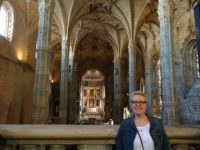 #28 took us back into town, where we got off at a lively square rocking out to a small group of drums and saxophones. We ducked into a bakery for dessert, where I was charmed by the girl behind the counter – she was energetic and friendly and had an adorable accent. From there, we walked a few minutes home.
#28 took us back into town, where we got off at a lively square rocking out to a small group of drums and saxophones. We ducked into a bakery for dessert, where I was charmed by the girl behind the counter – she was energetic and friendly and had an adorable accent. From there, we walked a few minutes home.
Mer made good on her promise of taking it easier today – only 6.8 miles of walking!